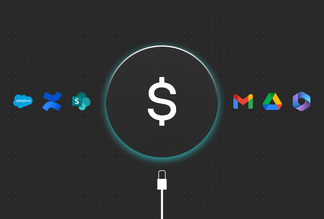
Starting off strong with a 30-60-90 day plan
As we reimagine our work day to help knowledge workers stay engaged, we have to consider how new employees feel in their first months of remote or hybrid work.
The first day of work looks a lot different now than it did just a year and a half ago. Going into the office to meet your coworkers for the first time has turned into receiving your company laptop in the mail and logging into an assortment of tools.
You may get the same amount of first-day jitters, but the truth is remote onboarding can be monotonous and isolating for the distributed knowledge worker.
If the future of work is hybrid, we have to focus on ways to asynchronously onboard new employees in order to facilitate inclusivity and flexibility around preferred working schedules. A 30-60-90-day program helps new hires get acclimated to their surroundings, even if they’re still working from the same home office.
The first 90 days as a modern worker
First impressions carry a lot of weight. We can easily understand a company’s values from how they treat onboarding. By creating a detailed plan with your new hire for the first months of employment, you emphasize how integral that person is to achieving company goals.
Regardless of how impressive one’s industry knowledge, experience, and skills are, even the strongest candidate faces a learning curve when entering a new role or joining a new organization. Setting the right goals off the bat is an effective strategy for getting everyone up to speed in the first three months of employment.
What is a 30-60-90 day plan?
Simply put, a 30-60-90-day plan is a strategy that outlines the professional intentions for the first three months of employment. Month one is 30 days, month two is 60 days, and month three is 90 days. Consider this your plan of attack, creating manageable goals that help individuals focus their attention and ease the transition into a new role.
Why teams use 30-60-90-day plans
How are 30-60-90-day plans effective, you ask? Creating monthly targets for the first three months of employment has benefits such as:
- Prioritizing tasks
- Creating measurable goals
- Helping employees stay focused and engaged
- Aligning goals to help define expectations
- Guiding priorities for new colleagues
- Improving productivity and better time management
- Allowing employees to achieve targets efficiently
For distributed teams specifically, the move to asynchronous models of progress and goal tracking becomes integral to a new employee’s success. Alternatives to sync time allow a modern worker greater flexibility, which boosts productivity and efficiency.
Elements of a 30-60-90-day plan
An effective 30-60-90-day plan is comprised of many details, but there will be four main elements:
- Onboarding process
- Priorities
- Goals
- Metrics for success
These elements (or phases) are designed to guide those in new roles. What will set your plan apart from any other? This lies within a people leader’s ability to set explicit goals for their direct reports and measure progress.
Here are the phases to consider for the first three months to help guide everyone to success:
Onboarding process
A solid onboarding strategy serves many essential purposes for an organization. Not only is it instrumental in securing an excellent experience for new hires, but it also sets the tone for company expectations.
The onboarding process can even increase employee engagement from the get-go. Onboarding the right way can reduce the time to proficiency and increase productivity by over 70%.
Defining expectations is critical within any onboarding process, and this is where your 30-60-90-day plan comes into effect. By developing company-aligned goals, you’ll focus your efforts where they’re needed most. Employees will get up to speed on the organization’s mission and values and the skills and knowledge required to perform their role.
Priorities
It’s not always easy to find your footing with a new company, especially if you’re doing so from home. A 30-60-90-day plan helps to acknowledge the learning curve and sets priorities for professional development.
A new employee should be shown the critical priorities for each monthly phase. As an example, priorities in the first 30 days may be centered around teaching the organization’s policies and procedures. The second month may focus on the skills and knowledge needed to work independently. Build priorities to new hires to achieve their goals through each phase, which in turn helps you achieve your own.
Goals
Once you’ve set priorities for your new hire, create quantifiable goals to help them be achieved. Organize these goals based on the priorities you’d like to accomplish within the first 30 days, the first 60 days, and the first 90 days to remain engaged and focused.
Metrics for success
How will you identify when goals have been achieved? Adopting precise metrics enables you to track overall progress, celebrate successes, and identify opportunities. Use quantifiable metrics such as revenue or qualitative metrics like testimonials or reviews to measure the results of goals best. Assess progress every 30 days and make amendments to your following 30-day plans where necessary.
How to write a 30-60-90-day plan
If you’re an employee coming into a new role, building your 90-day plan can help demonstrate your organizational skills and commitment to the new role.
Let’s say a 30-60-90 day plan doesn’t exist for new hires at your organization yet. This is a process you can work through with your manager to fully grasp the extent of your responsibilities and where you want to take your career.
→ Check out our 30-60-90 day template, if you need a structure to start with.
Understand your team’s goals
Four in 10 employees don’t fully understand what’s expected of them at work. Goal setting can help bridge this gap. Understanding team goals can provide focus and direction for all collaborators.
For best results, dig a little further. What is the purpose of each goal? How will the organization benefit from reaching these milestones? For new employees, a thorough understanding of team goals can offer guidance to align better individual goals and the motivation to meet targets. For management, clear, concise, and aligned goals will improve your team’s odds of exceeding objectives.
Ask questions
When developing your 30-60-90-day plan for a new job, asking the right questions can put you on the path to success. Studies have confirmed that new employees who are not afraid to ask questions and seek help perform better than their shy or egocentric counterparts. Making timely inquiries to management ensures your priorities align with your new organization and that you’re developing the right goals to succeed in your role.
Adopt a documentation process
Documentation is an essential practice in any business endeavor, and your 30-60-90-day strategy is no different. It helps to identify successes, failures, and best of all – opportunities.
A solid documentation process increases transparency among your team, improving the success of your strategy. However, managing a team of remote workers can pose significant challenges to your unit’s documentation process. With a Work Hub, you can promote transparency by integrating your plan with your Goals and documenting the process through a Workflow.
Within Qatalog, the 30-60-90 day plan can become a routine company-wide process readily available to be assigned as a Workflow to new joiners.
Set SMART goals
Goal setting is important, but setting SMART goals is the best way to increase your chances for team success.
S-specific
M-measurable
A-achievable
R-realistic
T-timely
As a manager, implementing SMART goals can help ensure team members can hit their targets. For new employees, SMART goals should be designed to direct focus and prioritize tasks.
Remember that initial goals can change
If the global pandemic has taught us anything – and startups will echo this sentiment – it’s that change is constant and unavoidable.
Be flexible with your 30-60-90-day plan and pivot goals where necessary. Reflect on your plan on a monthly basis (if not more frequently) to ensure priorities and goals haven’t changed. If they do change, roll with them. Adjust where necessary. Advocating for flexibility and embracing change helps you set realistic and achievable goals.
What a manager should do in the first 90 days
Not only will a solid strategy help you navigate the responsibilities of management, but it will also put you in the best position to lead your team.
You’ve been entrusted to make decisions that are best for the company. This is why your first focus in your initial 30 days should be to learn the organization’s ins and outs. A thorough understanding of the company’s focus, values, and culture will help you sharpen your decision-making skills.
With a comprehensive understanding of your new organization, you’re ready to contribute to the team. Find ways to offer advice and provide recommendations or solutions that are aligned with the company’s objective. Highlight your value.
Finally, don’t forget to be a leader for your team. Set expectations that are in line with company-wide goals, check in regularly with your team, and track your team’s progress through the right work hub. Acknowledge success and pivot goals and priorities as needed. This will help keep your group of remote workers accountable for their productivity and performance.
Writing a 30-60-90-day plan for a distributed team
The days of rigidly structured work environments are behind us. Some companies have even made the transition to working fully remote, including Shopify, whose 5,000 employees can now work from home indefinitely.
As of today, Shopify is a digital by default company. We will keep our offices closed until 2021 so that we can rework them for this new reality. And after that, most will permanently work remotely. Office centricity is over.
— Tobi Lutke 🌳🌲🛒🕹 (@tobi) May 21, 2020
So, how do you create a 30-60-90-day plan for a distributed workforce? Find success by implementing these tips:
- Align your goals to ensure all team members are working toward targets that reflect the company’s overall mission
- Improve communication channels and frequently connect through work hubs that facilitate team collaboration
- Pivot and adjust goals based on failures or missed opportunities
- Recognize and celebrate milestones collectively
Reinvent your onboarding with a Work Hub
We have a lot of outdated expectations about work. As we prepare for a hybrid working model, we have to be forward-thinking about creating practices that connect every person in the organization.
With a work hub, transparency becomes the baseline of this change. You can adopt 30-60-90 day practices in a Workflow that is fully automated, write goals that are connected with the rest of your company, and easily search for what your new team is working on.
Utilizing a company Work Hub to promote transparency of goals adds context and perspective for everyone, not just new hires.



